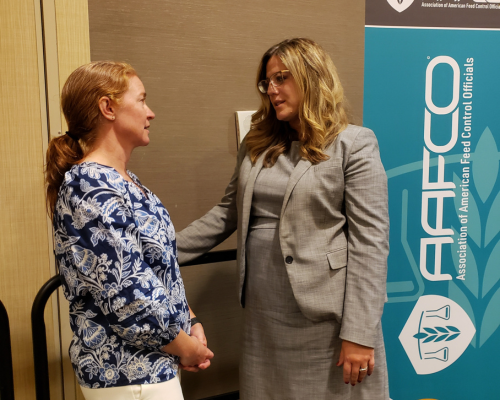
Written by: Louise Calderwood | August 15, 2024
Last week, a total of 430 in-person and virtual attendees from 43 states and six countries participated in the Association of American Feed Control Officials’ (AAFCO) annual meeting in San Antonio, Texas. Two AFIA staff members, Leah Wilkinson and myself, were on hand to engage in discussions on some of the hottest topics of the day —as hot as the 104-degree temperature.
These discussions took place as AAFCO delegates passed resolutions in response to the Food and Drug Administrations announcement of its intent to end the decades-long memorandum of understanding to review the safety of new animal food ingredients for AAFCO. The AAFCO board accepted resolutions to explore pathways to adopt the new FDA Animal Food Ingredient Consultation Program (AFIC) and allow the use of alternate (non-FDA) safety reviews for animal food ingredients through the AAFCO ingredient approval process. The board also resolved to consider ingredients recognized and approved by the Canadian Food Inspection Agency and the European Food Safety Authority.
accepted resolutions to explore pathways to adopt the new FDA Animal Food Ingredient Consultation Program (AFIC) and allow the use of alternate (non-FDA) safety reviews for animal food ingredients through the AAFCO ingredient approval process. The board also resolved to consider ingredients recognized and approved by the Canadian Food Inspection Agency and the European Food Safety Authority.
Tim Schell, FDA Center for Veterinary Medicine director of the office of surveillance and compliance, addressed AAFCO’s Current Issues and Outreach Committee, sharing a high-level update of the pending changes to the FDA animal food ingredient approval process. We will be seeking input from members as we develop comments on AFIC and provide input on requested changes to the ingredient approval process.
The AAFCO Ingredient Definitions Committee (IDC) approved all the investigator recommendations on the agenda, including moving eight ingredients from “tentative” to “official” status, approving two new tentative ingredients (“clam meal” sourced from species for human consumption and “black soldier fly larvae oil” for use in poultry diets), recognizing two taxonomic reclassifications and voting to add a Generally Recognized as Safe notice for a purified yeast cell wall product to Table 101.1. The committee also added seven ingredients to the Common Food Index.
The AAFCO Feed and Feed Ingredient Committee briefly discussed the work group’s progress on the consideration of the role of validated, third-party audit data when determining facility inspection frequency. The AAFCO Feed Labeling Committee spent considerable time reviewing the potential creation of non-structural carbohydrate guarantees for horse feed. The Model Bill and Regulations Committee discussed the use of dried insects in commercial exotic pet food and amended the definition of “commercial feed” to explicitly exempt products, such as rawhides and bones, which do not provide nutrition to the animal.
The AAFCO Pet Food Committee shared the results of the unsuccessful effort to create a “controlled copper” marketing term for dog food, a move we agreed with, and accepted the guidance document and frequently asked questions document for “human grade pet food.” Industry and regulators provided an update on the status of adoption of the modernized pet food label, which I have written about on the blog, including some of the roadblocks the new regulations are encountering when companies and states adopt them.
Despite the heat outside, cool heads prevailed in the committee rooms as regulators and the animal food industry collectively explored new systems, new ingredients and new definitions to advance animal nutrition and welfare.
Comments See our policy on comments